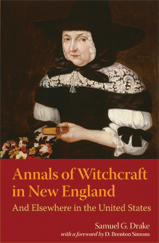 Our early New England ancestors were well acquainted with the threat of witchcraft. Dread of this phenomenon, and particularly of those in its thrall, was reinforced to them in warnings from clergymen about the dangers of falling in league with the devil. These fears were further punctuated by the occasional accusations or cases in various towns throughout the region. Authorities of no less stature than John Winthrop recorded such incidents in their diaries.
Our early New England ancestors were well acquainted with the threat of witchcraft. Dread of this phenomenon, and particularly of those in its thrall, was reinforced to them in warnings from clergymen about the dangers of falling in league with the devil. These fears were further punctuated by the occasional accusations or cases in various towns throughout the region. Authorities of no less stature than John Winthrop recorded such incidents in their diaries.
Sometimes accounts fell in line with popular conceptions of witches: women casting spells, performing tricks, reading minds, or meeting in covens. Other cases involved victims falling violently ill, possessed children gliding through the air or levitating above a bed, individuals failing curious witch “tests,” appearances by frightening imps, and even the fatal discovery of a tell-tale “witch’s teat” on the body of an accused woman.
Accusations were most frequently leveled against individuals, but sometimes against married couples or families or whole communities of families in a full-blown hysteria. In one possibly unique “hereditary” circumstance, three generations of women in a single family – Mary Hale of Boston, her daughter Winifred Benham, and a granddaughter of the same name – were all, over a number of years, accused of being witches in separate cases in two different colonies. In Boston, those accused of witchcraft were typically widows or single women who practiced some form of medicine and who had been caught up in disputes with neighbors or were more broadly troublesome to the community. Other casualties included those marginalized by society or otherwise damaged by the taint of an accusation and families ripped apart in the wake of an execution. In these and other cases, men and women of New England were tried and sometimes convicted and brutally executed. Some of the accused were acquitted or escaped trial altogether.
By 1869, antiquarian Samuel G. Drake, one of the founders of the New England Historic Genealogical Society, had collected records of cases and statutes regarding witchcraft, principally in New England, but including items of interest from as far away as Virginia and South Carolina, for the period 1636 to 1728; he gathered them for publication as Annals of Witchcraft in New England. Drake believed that books on witchcraft, sorcery, and magic had been brought to America by the earliest European settlers, who, influenced by the ideas in these texts, added to them with imagination. Concluding that witchcraft “itself was imported by those who first practiced it here, and was perpetuated by the Importers and their immediate Descendants,” he wanted to present the first anthology of original witchcraft records for publication. Today, Drake’s work is a resource worthy of renewed interest, one giving us a closer view into witchcraft in New England through the presentation of original materials, useful commentary, and the inclusion of several intriguing and lesser-known cases.
Adapted from the foreword to the new NEHGS edition of Samuel G. Drake’s Annals of Witchcraft in New England.
Note: Marilynne K. Roach will lecture at 6 p.m. at 99-101 Newbury Street in Boston on Wednesday, 12 March, on the subject of her new book, Six Women of Salem: The Untold Story of the Accused and Their Accusers in the Salem Witch Trials. For more information, please visit this page: http://www.americanancestors.org/Event.aspx?id=29938.
I will have to find this publication. While doing my family history, I came upon Alice Young, who was hung for witchcraft 50 years before Salem, in CT. She is in my line…..
Also look up John Putnam Demos, Understanding Satan (W W Norton and in pb) which covers all of NE cases from settlement to the past spasms in mid 1700s. Does cover the Hartford witch cases of 1660. Historical/sociological in approach; footnotes & bibliography are quite detailed with more personal detail and very useful leads to even more sources–my first recourse for trying to find more info on my friend’s ancestress Mary Barnes. A necessary text for scholars like Ms Roach & more local studies. Many academic histories are underutilized by general genealogists both for background and footnotes clue.
I believe the book that you are talking about is Entertaining Satan rather than Understanding Satan.
Elizabeth Periment wife of (1631 – 1714) wife of Stephen Clason iof Stamford is my
8th great grandmother I. Am aqareof books published about her trials, but there seems to be little or conflicting information on her parents and early years. Can
Anyoneshedany light on her?
Also I a related to another accused witch Mary Bliss
Wife of Joseph Parsons
Google it – – it can be read at Archive.org